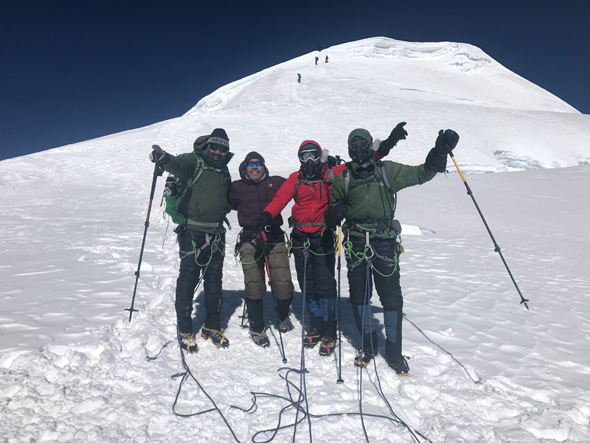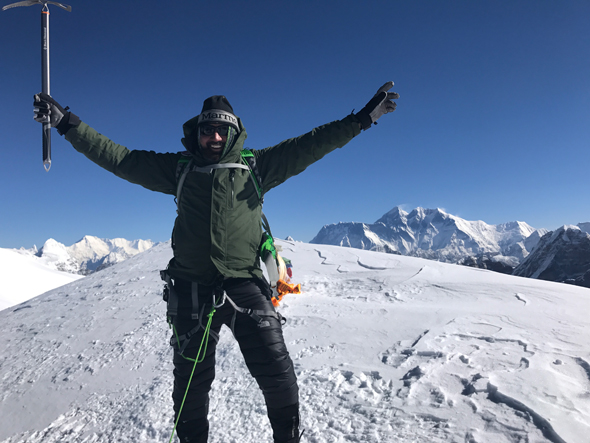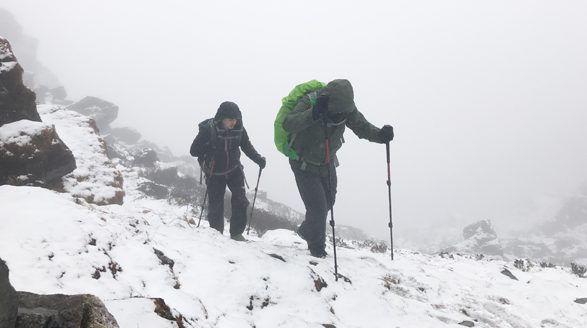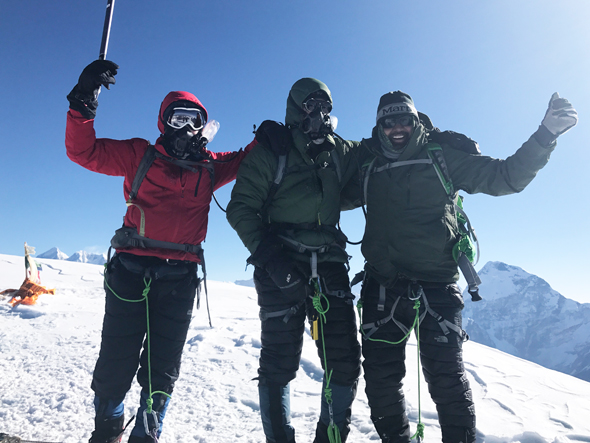Diary of My Climb to Mera Peak
Saved under Community, Current Stories, Travel
Tags: Baytown, Clear Lake, Cypress, Desi news, Greater Houston, Houston, Houston Desi news, India, Indian American community, Indian News, Indians in America, Indo-American News, Katy, NRI, pearland, south asia, South India, Sugar Land, Texas, USA
By Rick Pal
HOUSTON: Mera Peak is a mountain in Nepal’s Sagarmatha Zone. At 21,200 feet, it is the highest trekking peak in the world. Rick Pal, a Houston entrepreneur and executive, recently trekked to the top. This is an excerpt from Rick’s diary on the summit day.
High Camp. It was 1:30 am and I could feel the cold wind blowing outside our tent. I was glad that I was too tired when we got there few hours earlier to worry about the ropes barely holding down the tent at High Camp – situated on a cliff at almost 16,000 feet with wind speed at 20 knots.
I was sharing the tent with Navraj, who was from Katmandu, and had put together this trek. He was already outside as I could hear him talking to Dawa, our lead guide. Dawa was sharing a tent with our other guide, Laden. Both of them were up since midnight, making sure that we drank enough water, took our dose of Diamox to fight altitude sickness, and ate our garlic soup. Our next meal will be after the climb to summit when we swing by High Camp on our way down to base camp at Khare. Best-case scenario – maybe in 8 hours.
This was our tenth day in Himalayas. We started our trek in Lukla at 9,000 feet with an overcast sky and the weather only got worse. We had decided to take a shorter, but more strenuous route, to better acclimatize and shave off couple of days. However icy conditions, dangerous terrain, and extremely basic living conditions made us regret that decision. By third day, as we crossed over Zatrawa High Pass at 15,000 feet, altitude sickness, lack of sleep, weak appetite, and strenuous climbing started getting to us. Our team member, Ashnut from India decided to head back due to health issues.
Fortunately, the weather started clearing up as we trekked the valley on fourth and fifth day. Now that we were on the regular route, we also started seeing other folks headed to Mera. An extra night in Thagnak helped us get some much-needed rest. As we made our way to base camp of Khare on seventh day, we saw Mera for the first time – menacing and inviting at the same time. However, overcast weather returned and we started to get concerned about summiting after we met a group of climbers who had to turn back from Camp 1 at Mera La.
It was heartbreaking to see folks get so close and then having to quit. That’s when we started reviewing weather reports and the team decided to skip Mera La Camp and head straight to High Camp. This was to take advantage of a small opening of decent weather before high winds of 50 knots blew in the next day. However that meant a climb of over 3,000 feet in one day in fresh snow using fixed ropes for at least portions of it. By the time we got to High Camp on ninth day, I could feel the effects of exhaustion. I knew we only had few hours to mentally and physically prepare ourselves for the upcoming summit. Fatigue and nervousness made for a very weird and uncomfortable sleep.

From left: Rick Pal, Dawa Sherpa, Navraj Pradhan, Mike Hobson. Post summit with Mere Peak behind us.
Summit Climb. I could hear Dawa telling Mike, our fourth team member from Canada,“We need to leave before 2AM. Come on – let’s go.” I crawled out and was immediately hit by the night temperature of -25˚F. The only lights were those from our headlamps. We tied the rope to our harness and soon we were on our way to Mera Peak.
I felt the effects of steep climb to High Camp and lack of sleep right away. My legs were just too weak and the thought of climbing 2300 feet in dark at this altitude became too daunting. My hands and feet were freezing. Every 200-300 feet, we will come across a deep crevasse that we had to jump over. As I looked up I could see the steep slope rising before us based on the line that separated darkness from stars.
As we neared 20,000 feet, I started to slow down further. I slipped in a shallow crevasse and had trouble getting up. For the first time, I started having doubts. I did not want to hold back the group either. Dawa, sensing my exhaustion, convinced me to use oxygen tank. Not being used to the mask, it bothered me and was more of a nuisance than help. At this point, I asked Dawa if it would be OK to split the group in two. I wanted to catch my breath and rest my legs for a bit. The team agreed. Before they put on their oxygen masks and left with Dawa, Mike reminded me that “the trek down is more important so do not push yourself too much”. I nodded my head in acknowledgement.
Light was starting to peak through the clouds. I knew the sun was going to appear soon and with it the warmth and light. I was little over 1,500 feet away from the summit. Laden kept telling me that I could do it. I took stock of my situation and just could not come to terms with quitting at that point. I rechecked my gear and signaled Laden to lead the way. My second wind even surprised me. We kept within few hundred feet of first group and caught up with them at the base of the summit. Mike could not believe his eyes when he looked back and saw me. He nudged Navraj to look back and both of them cracked a smile in amazement.
At the Summit. Our group reached the summit at 7:35 am after using the fixed ropes to scale last 200 feet. It was cold and windy at the top. However, the sun was out and Mera Peak awarded us with one of the most desirable views in Himalayas. We saw five of six 26,000-ft peaks in Himalayas, including Everest. We spent less than 30 minutes on the summit.
Trek to Base Camp. Only after we got down to the base of the summit did we realize the enormity of what we had just achieved. I felt so fortunate to have had this opportunity and grateful for the weather. We were all smiling from ear to ear and spent few more minutes taking in the beautiful view before Dawa reminded us of the storm headed our way. The trek down to base camp in snow with limited visibility was tough, but we could all see the light at the end of the tunnel. Though relieved, we were all a bit sad with the realization that our Mera adventure was coming to an end soon.
Pushing My Limits. I made the decision to climb Mera because I wanted to push my mental and physical limits and do something in Himalayas as it always been a source of fascination for me. Now that I am back home safe and able to truly absorb it, I do believe that this experience will stay with me for the rest of my life. This was my “Everest” – beautiful and unforgiving. In a world where we live with too many rules, mountains offer freedom to explore – both the terrain and your own limits. It makes you appreciate simple things in life and have complete faith in people around you. I found strength and perseverance that I didn’t think was possible for me. I became a mountaineer on this trek. And I think I am a better person for it.
See Video Below:




